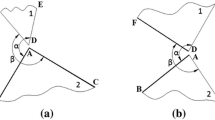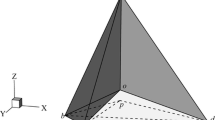Abstract
This study presents a novel angle-based contact detection method to address the concave contact problem of arbitrary polyhedra, including convex and concave polyhedra, those with cavities and/or holes, and likely their unions. First, the most important mathematical concept in this study, the angle, is introduced to represent a general polyhedron. Using angles, the topologies of the polyhedra can be far more complex and universal than those previously studied, allowing for the coplanarity of faces and collinearity of edges, and not limiting the polyhedra to simple homeomorphic to closed three-dimensional (3-D) spheres. Second, all the local entrances of two general angles, which are either vertex angle to half-space or crossing edge angle to edge angle entrances, are identified using the entrance formulas. Third, local convex decomposition (LCD) is proposed to decompose any arbitrarily concave angle into a set of convex subangles, making the method easy to implement and naturally compatible with detection of entrance angles. Fourth, the proposed entrance angle method (EAM) is implemented in 3-D discontinuous deformation analysis (DDA) to compute arbitrarily convex/concave contacts. Finally, the EAM-based 3-D DDA method is validated and then employed to investigate the discontinuous mechanical behaviors of complex polyhedral block systems. Overall, the extended 3-D DDA program is sufficiently developed to meet the analysis requirements of complex rock mass projects.























Similar content being viewed by others
References
Ahn T-Y, Song J-J (2011) New contact-definition algorithm using inscribed spheres for 3D discontinuous deformation analysis. Int J Comput Methods 8:171–191
Beyabanaki SAR, Mikola RG, Hatami K (2008) Three-dimensional discontinuous deformation analysis (3-D DDA) using a new contact resolution algorithm. Comput Geotech 35:346–356
Cheng YM, Chen WS, Zhang YH (2006) New approach to determine three-dimensional contacts in blocks system: penetration edges method. Int J Geomech 6:303–310
Cundall PA (1988) Formulation of a three-dimensional distinct element model—Part I. A scheme to detect and represent contacts in a system composed of many polyhedral blocks. In: International journal of rock mechanics and mining sciences & geomechanics abstracts, Elsevier, Amsterdam, pp 107–116
Cundall PA, Hart RD (1992) Numerical modelling of discontinua. Eng Comput 9:101–113
Duarte CA, Hamzeh ON, Liszka TJ, Tworzydlo WW (2001) A generalized finite element method for the simulation of three-dimensional dynamic crack propagation. Comput Methods Appl Mech Eng 190:2227–2262
Genhua SHI (2006) Producing joint polygons, cutting joint blocks and finding key blocks for general free surfaces [J]. Chin J Rock Mech Eng 11
Goodman RE (1989) Introduction to rock mechanics. Wiley, New York
Goodman RE (1995) Block theory and its application. In: Proc. of 35th US Symposium on Rock Mechanics (edited by JJK Daemen & RA Schultz). AA Balkema. Rotterdam. 1995b. str. pp 3–15
Goodman RE, Shi G (1985) Block theory and its application to rock engineering
Hart R, Cundall PA, Lemos J (1988) Formulation of a three-dimensional distinct element model—Part II. Mechanical calculations for motion and interaction of a system composed of many polyhedral blocks. In: International journal of rock mechanics and mining sciences and geomechanics abstracts, Elsevier, pp 117–125
He L, An XM, Ma GW, Zhao ZY (2013) Development of three-dimensional numerical manifold method for jointed rock slope stability analysis. Int J Rock Mech Min Sci 64:22–35
He L, An XM, Zhao ZY (2014) Development of contact algorithm for three-dimensional numerical manifold method. Int J Numer Methods Eng 97:423–453
Hencher SR, Lee SG, Carter TG et al (2011) Sheeting joints: characterisation, shear strength and engineering. Rock Mech Rock Eng 44(1):1–22
Hopkins MA (2014) Polyhedra faster than spheres? Eng Comput
Jelenić G, Crisfield MA (1996) Non-linear ‘master-slave’relationships for joints in 3-D beams with large rotations. Comput Methods Appl Mech Eng 135:211–228
Jiang QH, Yeung MR (2004) A model of point-to-face contact for three-dimensional discontinuous deformation analysis. Rock Mech Rock Eng 37:95–116
Kamai R, Hatzor YH (2008) Numerical analysis of block stone displacements in ancient masonry structures: a new method to estimate historic ground motions. Int J Numer Anal Methods 32(11):1321–1340
Keneti AR, Jafari A, Wu J-H (2008) A new algorithm to identify contact patterns between convex blocks for three-dimensional discontinuous deformation analysis. Comput Geotech 35:746–759
Liu XL, Lemos JV (2001) Procedure for contact detection in discrete element analysis. Adv Eng Softw 32:409–415
Liu S, Li Z, Zhang H et al (2018) A 3-D DDA damage analysis of brick masonry buildings under the impact of boulders in mountainous areas. J Mt Sci 15:657–671
Nadimi S, Miscovic I, McLennan J (2016) A 3D peridynamic simulation of hydraulic fracture process in a heterogeneous medium. J Pet Sci Eng 145:444–452
Nguyen BH, Zhuang X, Wriggers P et al (2017) Isogeometric symmetric Galerkin boundary element method for three-dimensional elasticity problems. Comput Methods Appl Mech Eng 323:132–150
Nilsson L (1990) A contact searching algorithm for general 3-D contact-impact problems. Comput Struct 34:327–335
Rabczuk T, Belytschko T (2007) A three-dimensional large deformation meshfree method for arbitrary evolving cracks. Comput Methods Appl Mech Eng 196:2777–2799
Shi GH (1995) Simplex integration for manifold method and discontinuous deformation analysis. In: Proceedings of the first international conference on analysis of discontinuous deformation, Chungli, Taiwan, pp 1–25
Shi G (2001) Three dimensional discontinuous deformation analyses. In: DC Rocks 2001, The 38th US Symposium on Rock Mechanics (USRMS). American Rock Mechanics Association
Shi GH (2002) Single and multiple block limit equilibrium of key block method and discontinuous deformation analysis. In: Proceedings of the 5th international conference on analysis of discontinuous deformation, Rotterdam: AA Balkema. pp 3–43
Shi G (2015) Contact theory. Sci Chin Technol Sci 58:1450–1496
Shi G, Goodman RE (1989) The key blocks of unrolled joint traces in developed maps of tunnel walls. Int J Numer Anal Methods Geomech 13:131–158
Sukumar N, Moës N, Moran B, Belytschko T (2000) Extended finite element method for three-dimensional crack modelling. Int J Numer Methods Eng 48:1549–1570
Temizer I, Wriggers P, Hughes TJR (2012) Three-dimensional mortar-based frictional contact treatment in isogeometric analysis with NURBS. Comput Methods Appl Mech Eng 209:115–128
Tonon F, Asadollahi P (2008) Validation of general single rock block stability analysis (BS3D) for wedge failure. Int J Rock Mech Min Sci 45(4):627–637
Wang GH, Suemine A, Schulz WH (2010) Shear-rate-dependent strength control on the dynamics of rainfall-triggered landslides. Earth Surf Proc Land 35(4):407–416
Wang J, Li S, Feng C (2015) A shrunken edge algorithm for contact detection between convex polyhedral blocks. Comput Geotech 63:315–330
Wang W, Chen G, Zhang H et al (2016) Analysis of landslide-generated impulsive waves using a coupled DDA-SPH method. Eng Anal Bound Elem 64:267–277
Wang X, Wu W, Zhu H et al (2019) Contact detection between polygonal blocks based on a novel multi-cover system for discontinuous deformation analysis. Comput Geotech 111:56–65
Wang X, Wu W, Zhu H et al (2020) The last entrance plane method for contact indeterminacy between convex polyhedral blocks. Comput Geotech 117:103283
Williams J, Lu Y, Trinkle JC (2017) A geometrically exact contact model for polytopes in multirigid-body simulation. J Comput Nonlinear Dyn 12:21001
Wu J-H (2008) New edge-to-edge contact calculating algorithm in three-dimensional discrete numerical analysis. Adv Eng Softw 39:15–24
Wu J, Juang CH, Lin H (2005) Vertex-to-face contact searching algorithm for three-dimensional frictionless contact problems. Int J Numer Methods Eng 63:876–897
Wu W, Zhu H, Zhuang X et al (2014) A multi-shell cover algorithm for contact detection in the three dimensional discontinuous deformation analysis. Theor Appl Fract Mech 72:136–149
Wu W, Zhu H, Lin J-S et al (2018) Tunnel stability assessment by 3D DDA-key block analysis. Tunn Undergr Sp Technol 71:210–214
Wu W, Wang X, Zhu H et al (2019) Improvements in DDA program for rockslides with local in-circle contact method and modified open-close iteration. Eng Geol 105433
Yeung MR, Jiang QH, Sun N (2003) Validation of block theory and three-dimensional discontinuous deformation analysis as wedge stability analysis methods. Int J Rock Mech Min Sci 40(2):265–275
Yeung MR, Jiang QH, Sun N (2007) A model of edge-to-edge contact for three-dimensional discontinuous deformation analysis. Comput Geotech 34:175–186
Zhang H, Chen G, Zheng L et al (2015) Detection of contacts between three-dimensional polyhedral blocks for discontinuous deformation analysis. Int J rock Mech Min Sci 78:57–73
Zhang H, Liu S, Chen G et al (2016a) Extension of three-dimensional discontinuous deformation analysis to frictional-cohesive materials. Int J Rock Mech Min Sci 86:65–79
Zhang H, Liu S, Han Z et al (2016b) A new algorithm to identify contact types between arbitrarily shaped polyhedral blocks for three-dimensional discontinuous deformation analysis. Comput Geotech 80:1–15
Zhang H, Liu S, Zheng L et al (2016c) Extensions of edge-to-edge contact model in three-dimensional discontinuous deformation analysis for friction analysis. Comput Geotech 71:261–275
Zhang Q-H, Ding X-L, Wu A-Q (2017) A comparison of the application of block theory and 3D block-cutting analysis. Int J Rock Mech Min Sci 99:39–49
Zhang H, Liu S, Wang W et al (2018a) A new DDA model for kinematic analyses of rockslides on complex 3-D terrain. Bull Eng Geol Environ 77:555–571
Zhang H, Liu S, Zheng L et al (2018b) Method for resolving contact indeterminacy in three-dimensional discontinuous deformation analysis. Int J Geomech 18:4018130
Zhang Q, Lin S, Ding X, Wu A (2018c) Triangulation of simple arbitrarily shaped polyhedra by cutting off one vertex at a time. Int J Numer Methods Eng 114:517–534
Zhao G, Fang J, Zhao J (2011) A 3D distinct lattice spring model for elasticity and dynamic failure. Int J Numer Anal Methods Geomech 35:859–885
Zheng H, Zhang P, Du X (2016) Dual form of discontinuous deformation analysis. Comput Methods Appl Mech Eng 305:196–216
Zheng F, Jiao Y, Sitar N (2018) Generalized contact model for polyhedra in three-dimensional discontinuous deformation analysis. Int J Numer Anal Methods Geomech 42:1471–1492
Zhu H, Wu W, Chen J et al (2016) Integration of three dimensional discontinuous deformation analysis (DDA) with binocular photogrammetry for stability analysis of tunnels in blocky rockmass. Tunn Undergr Sp Technol 51:30–40
Acknowledgements
Thanks are due to Dr. Gen-hua SHI for his careful guidance and help. This study was sponsored by National Natural Science Foundation of China (51708420), Natural Science Foundation of Shanghai (17ZR1432300) and Key Laboratory of Mountain Hazards and Surface Process, Chinese Academy of Sciences.
Author information
Authors and Affiliations
Corresponding authors
Additional information
Publisher's Note
Springer Nature remains neutral with regard to jurisdictional claims in published maps and institutional affiliations.
Rights and permissions
About this article
Cite this article
Zhang, H., Zhang, Jw., Wu, W. et al. Angle-Based Contact Detection in Discontinuous Deformation Analysis. Rock Mech Rock Eng 53, 5545–5569 (2020). https://doi.org/10.1007/s00603-020-02206-z
Received:
Accepted:
Published:
Issue Date:
DOI: https://doi.org/10.1007/s00603-020-02206-z




